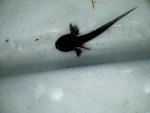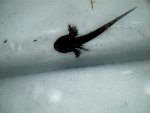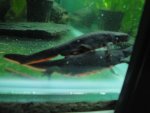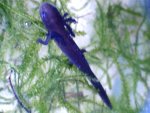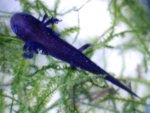RobM
New member
- Joined
- Jan 14, 2010
- Messages
- 477
- Reaction score
- 13
- Points
- 0
- Location
- London / Kent
- Country
- United Kingdom
- Display Name
- Rob M.
Hi everyone,
I come to you today, incredibly confused...
I was doing my routinely water change for my C.orientalis, and I suddenly noticed something in front of the pump I use to extract water/debris. I was like...."hmmm hang on... I know what that is" , so quickly I removed the pump and turned it off so I didn't suck it up. I then had another proper look, and it was confirmed, there was a little newt larvae!
, so quickly I removed the pump and turned it off so I didn't suck it up. I then had another proper look, and it was confirmed, there was a little newt larvae!
Now...how is this possible, I ask myself.
I believed (and still do), that all my C.orientalis are male...and besides, I have seen no evidence of eggs, or anything else related to them. I have checked over the whole tank, and no signs of anything else. I had the whole tank emptied 3/4 weeks ago for a thorough clean, so how is this one even possible.
Now I did move some plants around when I did my thorough clean, so I ask myself if they could have been transfered from elsewhere. Now my N.Kaiseri are all female, and all their eggs have been duds (besides I don't recall moving plants from them), so it cannot be from them.
Now that leaves the empty tanks. Yes, I definitely took plants from those, but they had no newts in them. I had some C.pyrrhogaster eggs a couple months ago, but the larvae all died, and it would be too long ago to be this size (besides they were not in this tank). Also the colour and size is all wrong in comparison.
It certainly is small enough to be C.orientalis as it is about 1cm long (and already has front legs), however its darker than C.orientalis larvae I have had in the past.
Anyway, what do you guys think?
Also, what should I do with it now? I have removed it from the adults, as it is certainly mouth sized still, but I don't have any food for it at the moment. I have started the brine shrimp up, but they will take a while to hatch. I have put lots of water and plants from the adults tank, to provide a natural source of food, however, I doubt there is much to eat.
Any advice and comments, much appreciated, thanks!
I come to you today, incredibly confused...
I was doing my routinely water change for my C.orientalis, and I suddenly noticed something in front of the pump I use to extract water/debris. I was like...."hmmm hang on... I know what that is"
Now...how is this possible, I ask myself.
I believed (and still do), that all my C.orientalis are male...and besides, I have seen no evidence of eggs, or anything else related to them. I have checked over the whole tank, and no signs of anything else. I had the whole tank emptied 3/4 weeks ago for a thorough clean, so how is this one even possible.
Now I did move some plants around when I did my thorough clean, so I ask myself if they could have been transfered from elsewhere. Now my N.Kaiseri are all female, and all their eggs have been duds (besides I don't recall moving plants from them), so it cannot be from them.
Now that leaves the empty tanks. Yes, I definitely took plants from those, but they had no newts in them. I had some C.pyrrhogaster eggs a couple months ago, but the larvae all died, and it would be too long ago to be this size (besides they were not in this tank). Also the colour and size is all wrong in comparison.
It certainly is small enough to be C.orientalis as it is about 1cm long (and already has front legs), however its darker than C.orientalis larvae I have had in the past.
Anyway, what do you guys think?
Also, what should I do with it now? I have removed it from the adults, as it is certainly mouth sized still, but I don't have any food for it at the moment. I have started the brine shrimp up, but they will take a while to hatch. I have put lots of water and plants from the adults tank, to provide a natural source of food, however, I doubt there is much to eat.
Any advice and comments, much appreciated, thanks!

